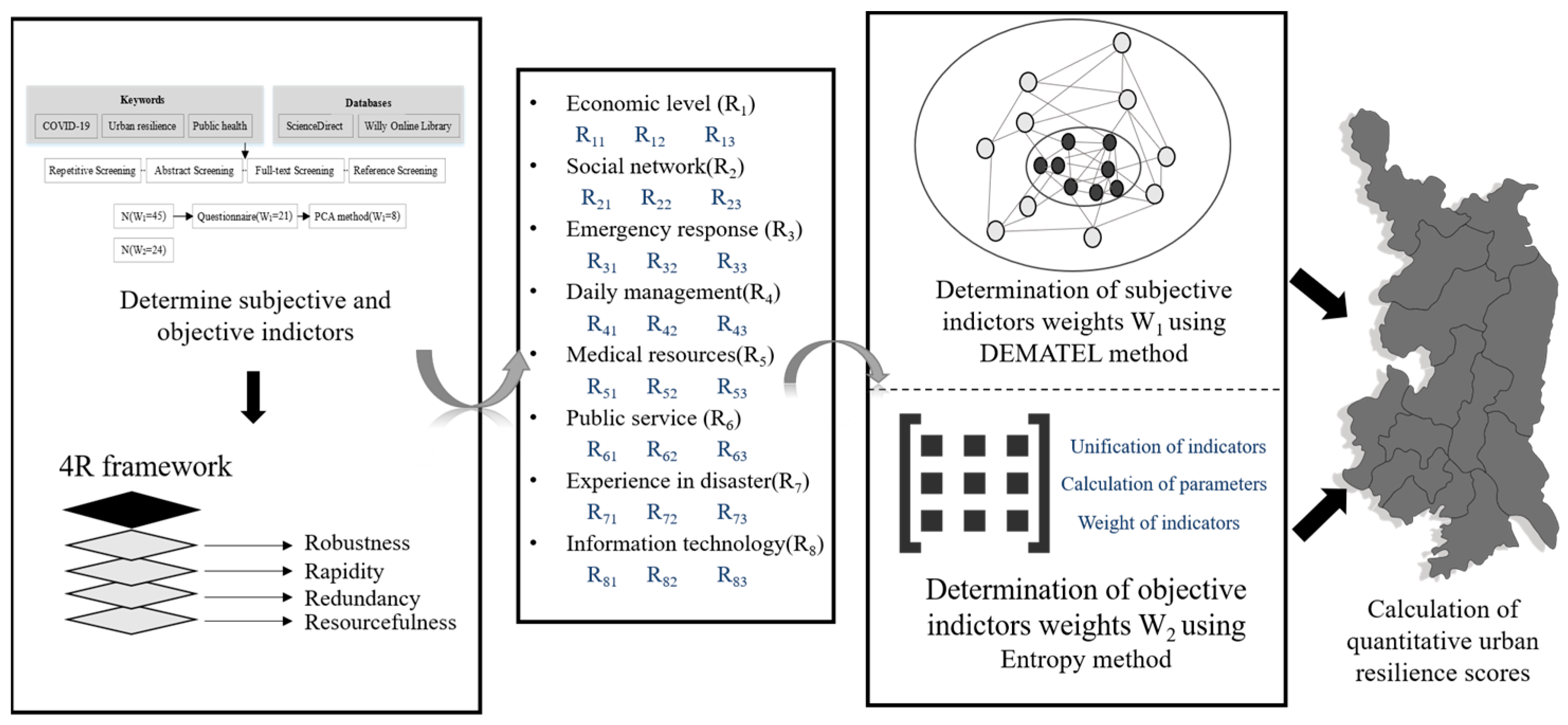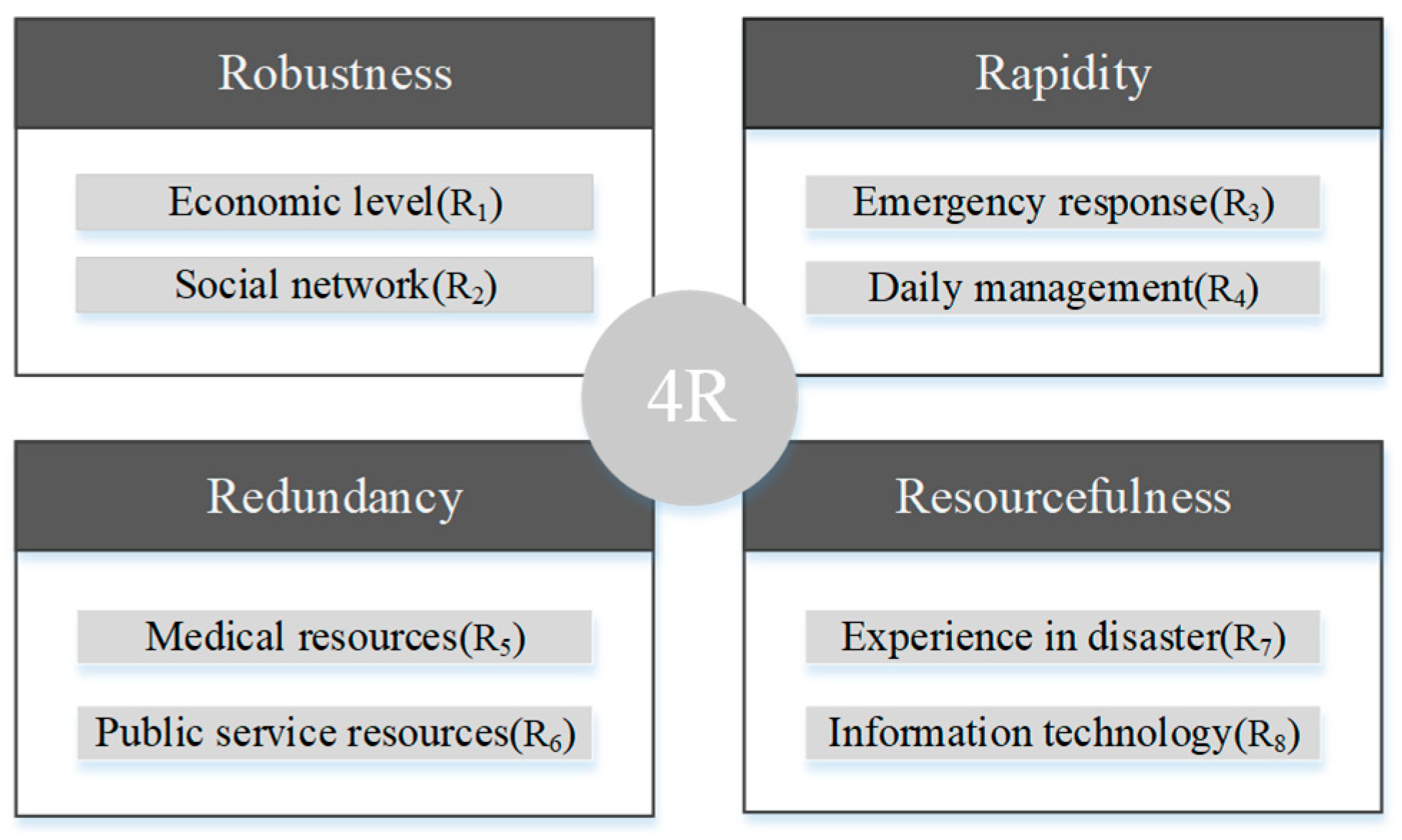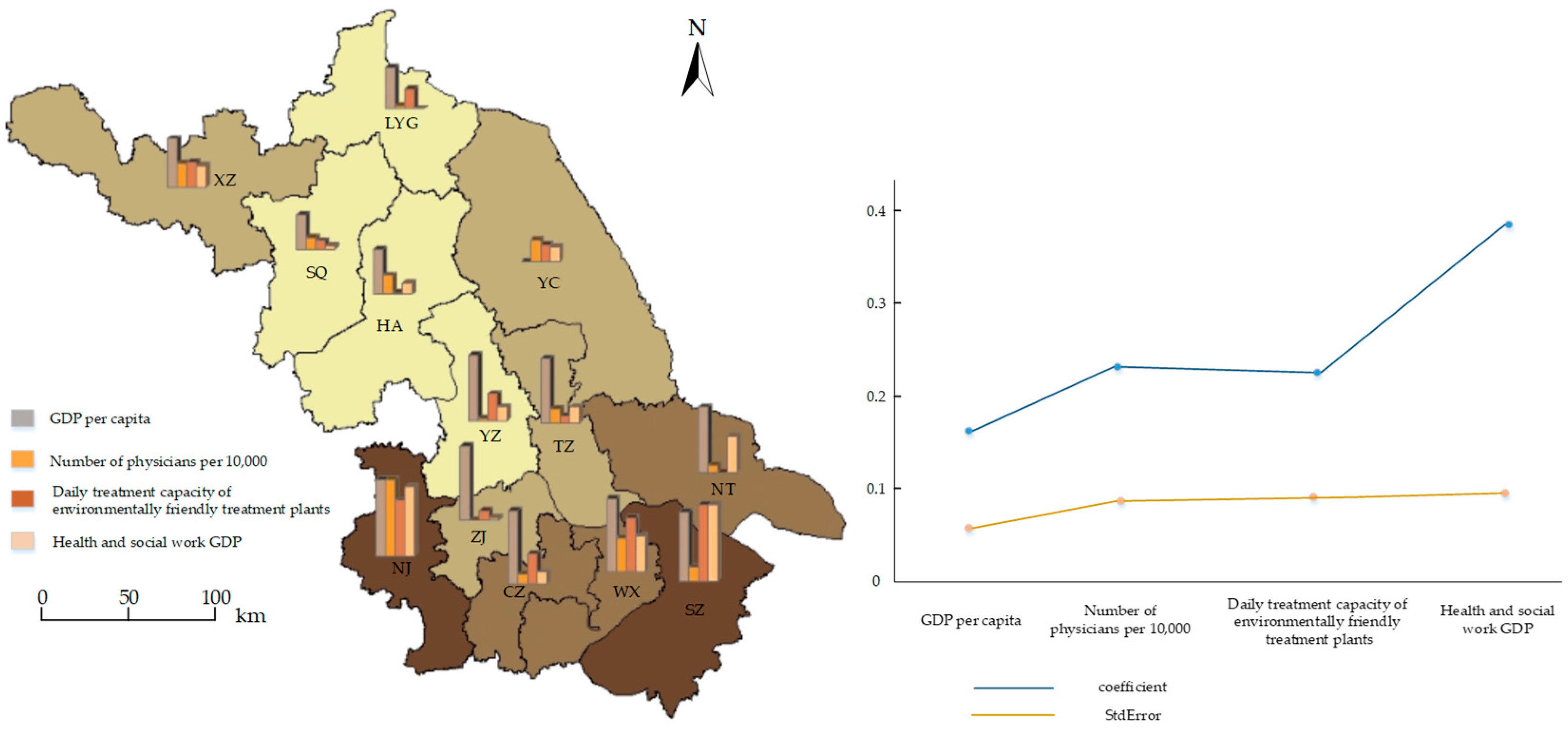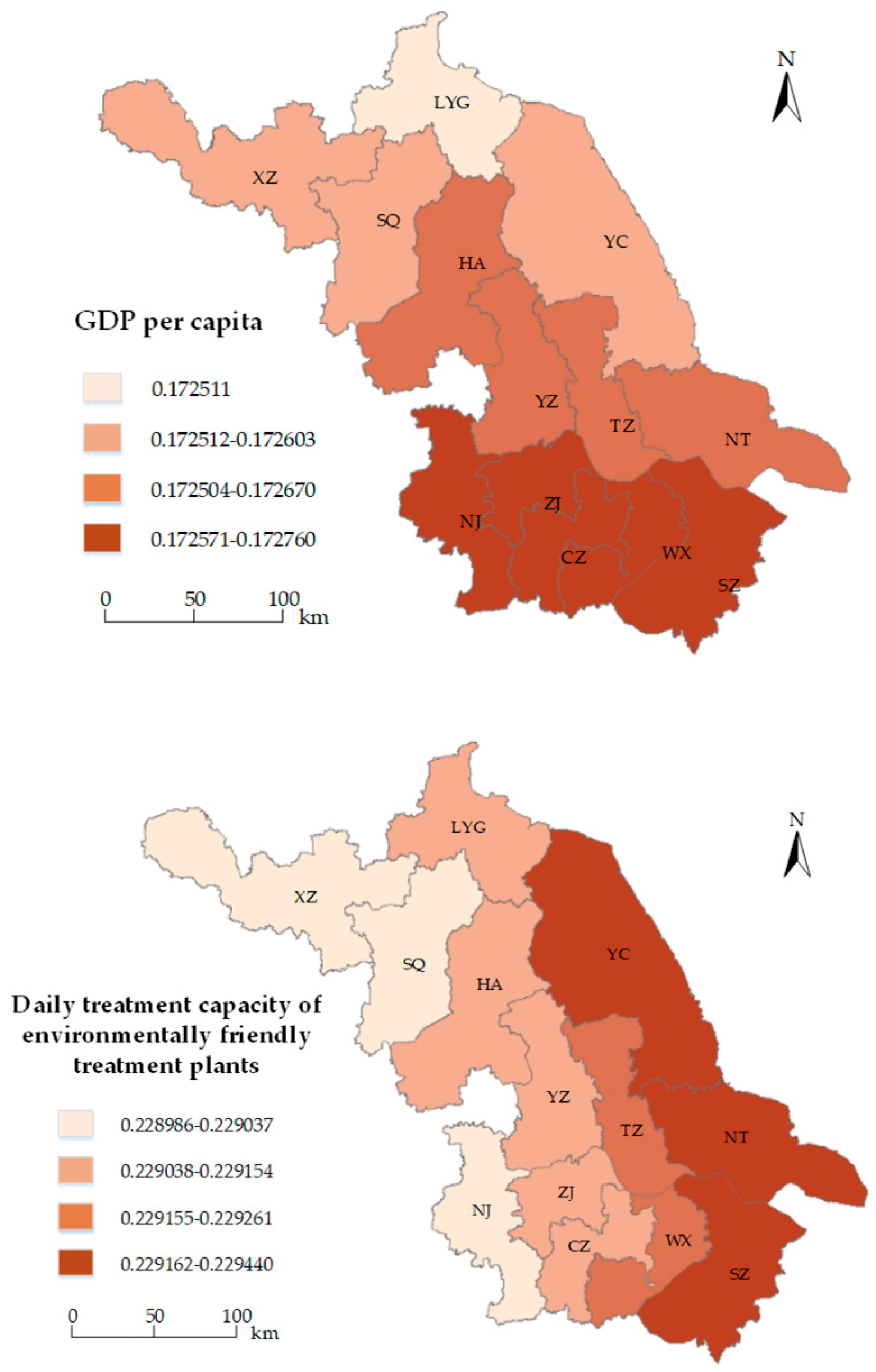Measuring the Urban Resilience Abased on Geographically Weighted Regression (GWR) Model in the Post-Pandemic Era: A Case Study of Jiangsu Province, China
Abstract
1. Introduction
2. Literature Review
2.1. The Definition and Characteristics of Resilience
2.2. Resilience in the Face of Public Health Crises
2.3. Assessment of Urban Resilience
3. Materials and Methods
3.1. Identification of Influencing Factors
3.1.1. The Identification of Resilience Assessment Indicators
3.1.2. The Identification of Quantitative Indicators
3.2. Analysis of Resilience Assessment Indicators by DEMATEL
3.3. Analysis of Quantitative Indicators Using Entropy Method
3.4. Calculation of Evaluation Indicator Combinations
4. Discussion
4.1. GWR Modeling
4.2. Spatial Characterization of Influencing Factors
5. Conclusions
Author Contributions
Funding
Data Availability Statement
Conflicts of Interest
References
- Liu, Z.; Ma, R.; Wang, H. Assessing urban resilience to public health disaster using the rough analytic hierarchy process method: A regional study in China. J. Saf. Sci. Resil. 2022, 3, 93–104. [Google Scholar] [CrossRef]
- Kraemer, M.U.G.; Yang, C.-H.; Gutierrez, B.; Wu, C.-H.; Klein, B.; Pigott, D.M.; du Plessis, L.; Faria, N.R.; Li, R.; Hanage, W.P.; et al. The effect of human mobility and control measures on the COVID-19 epidemic in China. Science 2020, 368, 493–497. [Google Scholar] [CrossRef]
- Xu, G.; Jiang, Y.; Wang, S.; Qin, K.; Ding, J.; Liu, Y.; Lu, B. Spatial disparities of self-reported COVID-19 cases and influencing factors in Wuhan, China. Sustain. Cities Soc. 2022, 76, 103485. [Google Scholar] [CrossRef]
- Wang, C.; Li, X.; Li, S. How Does the Concept of Resilient City Work in Practice? Planning and Achievements. Land 2021, 10, 1319. [Google Scholar] [CrossRef]
- Mahmoud, H.; Kirsch, T.; O’Neil, D.; Anderson, S. The resilience of health care systems following major disruptive events: Current practice and a path forward. Reliab. Eng. Syst. Saf. 2023, 235, 109264. [Google Scholar] [CrossRef]
- Meerow, S.; Newell, J.P.; Stults, M. Defining urban resilience: A review. Landsc. Urban Plan. 2016, 147, 38–49. [Google Scholar] [CrossRef]
- Li, L.; Yu, P.; Liu, Z. The dynamic evolution mechanism of public health risk perception and the choice of policy tools in the post-epidemic era: Evidence from China. Int. J. Disaster Risk Reduct. 2022, 77, 103056. [Google Scholar] [CrossRef]
- Huizenga, S.; Oldenhof, L.; van de Bovenkamp, H.; Bal, R. Governing the resilient city: An empirical analysis of governing techniques. Cities 2023, 135, 104237. [Google Scholar] [CrossRef]
- Naef, P. Resistances in the “Resilient City”: Rise and fall of a disputed concept in New Orleans and Medellin. Politi. Geogr. 2022, 96, 102603. [Google Scholar] [CrossRef]
- Gerges, F.; Assaad, R.H.; Nassif, H.; Bou-Zeid, E.; Boufadel, M.C. A perspective on quantifying resilience: Combining community and infrastructure capitals. Sci. Total. Environ. 2023, 859, 160187. [Google Scholar] [CrossRef]
- Holling, C.S. Resilience and Stability of Ecological Systems. Annu. Rev. Ecol. Syst. 1973, 4, 1–23. [Google Scholar] [CrossRef]
- Koliou, M.; van de Lindt, J.W.; McAllister, T.P.; Ellingwood, B.R.; Dillard, M.; Cutler, H. State of the research in community resilience: Progress and challenges. Sustain. Resilient Infrastruct. 2018, 5, 131–151. [Google Scholar] [CrossRef]
- Cui, P.; Liu, Y.; Ju, X.; Gu, T. Key Influencing Factors and Optimization Strategy of Epidemic Resilience in Urban Communities—A Case Study of Nanjing, China. Int. J. Environ. Res. Public Health 2022, 19, 9993. [Google Scholar] [CrossRef]
- Al-Humaiqani, M.M.; Al-Ghamdi, S.G. The built environment resilience qualities to climate change impact: Concepts, frameworks, and directions for future research. Sustain. Cities Soc. 2022, 80, 103797. [Google Scholar] [CrossRef]
- Galaitsi, S.; Kurth, M.; Linkov, I. Resilience: Directions for an Uncertain Future Following the COVID-19 Pandemic. Geohealth 2021, 5, e2021GH000447. [Google Scholar] [CrossRef]
- Shutters, S.T.; Muneepeerakul, R.; Lobo, J. Quantifying urban economic resilience through labour force interdependence. Palgrave Commun. 2015, 1, 15010. [Google Scholar] [CrossRef]
- Bruneau, M.; Chang, S.E.; Eguchi, R.T.; Lee, G.C.; O’Rourke, T.D.; Reinhorn, A.M.; Shinozuka, M.; Tierney, K.; Wallace, W.A.; Von Winterfeldt, D. A Framework to Quantitatively Assess and Enhance the Seismic Resilience of Communities. Earthq. Spectra 2003, 19, 733–752. [Google Scholar] [CrossRef]
- Aburn, G.; Gott, M.; Hoare, K. What is resilience? An Integrative Review of the empirical literature. J. Adv. Nurs. 2016, 72, 980–1000. [Google Scholar] [CrossRef]
- Aldrich, D.P.; Meyer, M.A. Social Capital and Community Resilience. Am. Behav. Sci. 2015, 59, 254–269. [Google Scholar] [CrossRef]
- Bakkensen, L.A.; Fox-Lent, C.; Read, L.K.; Linkov, I. Validating Resilience and Vulnerability Indices in the Context of Natural Disasters. Risk Anal. 2017, 37, 982–1004. [Google Scholar] [CrossRef]
- Fu, H.; Hong, N.; Liao, C. Spatio-temporal patterns of Chinese urban recovery and system resilience under the pandemic new normal. Cities 2023, 140, 104385. [Google Scholar] [CrossRef]
- Bruneau, M.; Reinhorn, A. Exploring the Concept of Seismic Resilience for Acute Care Facilities. Earthq. Spectra 2007, 23, 41–62. [Google Scholar] [CrossRef]
- Zhang, J.; Wang, T. Urban resilience under the COVID-19 pandemic: A quantitative assessment framework based on system dynamics. Cities 2023, 136, 104265. [Google Scholar] [CrossRef] [PubMed]
- Du, S.; Tan, H. Location Is Back: The Influence of COVID-19 on Chinese Cities and Urban Governance. Sustainability 2022, 14, 3347. [Google Scholar] [CrossRef]
- Yan, R.; Cao, F. Improving Public Health and Governance in COVID-19 Response: A Strategic Public Procurement Per-spective. Front. Public Health 2022, 10, 897731. [Google Scholar] [CrossRef]
- Mena, C.; Karatzas, A.; Hansen, C. International trade resilience and the COVID-19 pandemic. J. Bus. Res. 2022, 138, 77–91. [Google Scholar] [CrossRef] [PubMed]
- Fan, Y.; Fang, C. Research on the synergy of urban system operation—Based on the perspective of urban metabolism. Sci. Total. Environ. 2019, 662, 446–454. [Google Scholar] [CrossRef]
- Ribeiro, P.J.G.; Pena Jardim Gonçalves, L.A. Urban resilience: A conceptual framework. Sustain. Cities Soc. 2019, 50, 101625. [Google Scholar] [CrossRef]
- Li, Y.; Chen, K.; Collignon, S.; Ivanov, D. Ripple effect in the supply chain network: Forward and backward disruption propagation, network health and firm vulnerability. Eur. J. Oper. Res. 2021, 291, 1117–1131. [Google Scholar] [CrossRef]
- Feng, X.; Xiu, C.; Bai, L.; Zhong, Y.; Wei, Y. Comprehensive evaluation of urban resilience based on the perspective of landscape pattern: A case study of Shenyang city. Cities 2020, 104, 102722. [Google Scholar] [CrossRef]
- He, W.; Li, X.; Yang, J.; Ni, H.; Sang, X. How land use functions evolve in the process of rapid urbanization: Evidence from Jiangsu Province, China. J. Clean. Prod. 2022, 380, 134877. [Google Scholar] [CrossRef]
- Dou, F.; Xing, H.; Li, X.; Yuan, F.; Lu, Z.; Li, X.; Ge, W. 3D geological suitability evaluation for urban underground space development-A case study of Qianjiang New-town in Hangzhou, Eastern China. Tunn. Undergr. Space Technol. 2021, 115, 104052. [Google Scholar] [CrossRef]
- Qiu, D.; Chen, Q.; Xue, Y.; Su, M.; Liu, Y.; Cui, J.; Zhou, B. A new method for risk assessment of water inrush in a subsea tunnel crossing faults. Mar. Georesources Geotechnol. 2021, 40, 679–689. [Google Scholar] [CrossRef]
- Zhang, J.; Wang, Y.; Zhou, M.; Ke, J. Community resilience and anxiety among Chinese older adults during COVID-19: The moderating role of trust in local government. J. Community Appl. Soc. Psychol. 2021, 32, 411–422. [Google Scholar] [CrossRef]
- Stevenson, C.; Wakefield, J.R.H.; Felsner, I.; Drury, J.; Costa, S. Collectively coping with coronavirus: Local community identification predicts giving support and lockdown adherence during the COVID-19 pandemic. Br. J. Soc. Psychol. 2021, 60, 1403–1418. [Google Scholar] [CrossRef]
- Coram, V.; Louth, J.; Tually, S.; Goodwin-Smith, I. Community service sector resilience and responsiveness during the COVID-19 pandemic: The Australian experience. Aust. J. Soc. Issues 2021, 56, 559–578. [Google Scholar] [CrossRef]
- Carroll, R.; Prentice, C.R. Community vulnerability and mobility: What matters most in spatio-temporal modeling of the COVID-19 pandemic? Soc. Sci. Med. 2021, 287, 114395. [Google Scholar] [CrossRef]
- Guo, X.; Kapucu, N.; Huang, J. Examining resilience of disaster response system in response to COVID-19. Int. J. Disaster Risk Reduct. 2021, 59, 102239. [Google Scholar] [CrossRef]
- Monsen, K.A.; Austin, R.R.; Goparaju, B.; Jones, R.C.; Mathiason, M.A.; Pirsch, A.; Eder, M. Exploring Large Community- and Clinically-Generated Datasets to Understand Resilience Before and During the COVID-19 Pandemic. J. Nurs. Sch. 2021, 53, 262–269. [Google Scholar] [CrossRef]
- Labrague, L.J.; Ballad, C.A. Lockdown fatigue among college students during the COVID-19 pandemic: Predictive role of personal resilience, coping behaviors, and health. Perspect. Psychiatr. Care 2021, 57, 1905–1912. [Google Scholar] [CrossRef]
- Govindasamy, L.S.; Hsiao, K.H.; Foong, L.H.; Judkins, S. Planning for the next pandemic: Reflections on the early phase of the Australian COVID-19 public health response from the emergency department. Emerg. Med. Australas. 2021, 33, 759–761. [Google Scholar] [CrossRef] [PubMed]
- Czabanowska, K.; Kuhlmann, E. Public health competences through the lens of the COVID-19 pandemic: What matters for health workforce preparedness for global health emergencies. Int. J. Health Plan. Manag. 2021, 36, 14–19. [Google Scholar] [CrossRef] [PubMed]
- Kılınç, T.; Çelik, A.S. Relationship between the social support and psychological resilience levels perceived by nurses during the COVID-19 pandemic: A study from Turkey. Perspect. Psychiatr. Care 2021, 57, 1000–1008. [Google Scholar] [CrossRef] [PubMed]
- Peñacoba, C.; Velasco, L.; Catalá, P.; Gil-Almagro, F.; García-Hedrera, F.J.; Carmona-Monge, F.J. Resilience and anxiety among intensive care unit professionals during the COVID-19 pandemic. Nurs. Crit. Care 2021, 26, 501–509. [Google Scholar] [CrossRef] [PubMed]
- Litam, S.D.A.; Ausloos, C.D.; Harrichand, J.J.S. Stress and Resilience Among Professional Counselors During the COVID-19 Pandemic. J. Couns. Dev. 2021, 99, 384–395. [Google Scholar] [CrossRef] [PubMed]
- Yang, Q.; Wang, Y.; Tian, C.; Chen, Y.; Mao, J. The Experiences of Community-dwelling older adults during the COVID-19 Lockdown in Wuhan: A qualitative study. J. Adv. Nurs. 2021, 77, 4805–4814. [Google Scholar] [CrossRef]
- Yeom, M.; Stewart, F.; Stewart, A. The impact of social distancing on community case count in the United States: Testing the efficacy of protection motivation theory during early stages of the COVID-19 pandemic. Risk Hazards Crisis Public Policy 2021, 12, 303–327. [Google Scholar] [CrossRef]
- Billiet, A.; Dufays, F.; Friedel, S.; Staessens, M. The resilience of the cooperative model: How do cooperatives deal with the COVID-19 crisis? Strateg. Change 2021, 30, 99–108. [Google Scholar] [CrossRef]
- Therrien, M.-C.; Jutras, M.; Usher, S. Including quality in Social network analysis to foster dialogue in urban resilience and adaptation policies. Environ. Sci. Policy 2019, 93, 1–10. [Google Scholar] [CrossRef]
- Du, Z.; Zhang, H.; Ye, Y.; Jin, L.; Xu, Q. Urban shrinkage and growth: Measurement and determinants of economic resilience in the Pearl River Delta. J. Geogr. Sci. 2019, 29, 1331–1345. [Google Scholar] [CrossRef]
- Peñacoba, C.; Catala, P.; Velasco, L.; Carmona-Monge, F.J.; Garcia-Hedrera, F.J.; Gil-Almagro, F. Stress and quality of life of intensive care nurses during the COVID-19 pandemic: Self-efficacy and resilience as resources. Nurs. Crit. Care 2021, 26, 493–500. [Google Scholar] [CrossRef] [PubMed]
- Yulianto, E.; Yusanta, D.A.; Utari, P.; Satyawan, I.A. Community adaptation and action during the emergency response phase: Case study of natural disasters in Palu, Indonesia. Int. J. Disaster Risk Reduct. 2021, 65, 102557. [Google Scholar] [CrossRef]
- Haythornthwaite, C. Social network analysis: An approach and technique for the study of information exchange. Libr. Inf. Sci. Res. 1996, 18, 323–342. [Google Scholar] [CrossRef]
- Wolf, J.; Adger, W.N.; Lorenzoni, I.; Abrahamson, V.; Raine, R. Social capital, individual responses to heat waves and climate change adaptation: An empirical study of two UK cities. Glob. Environ. Chang. 2010, 20, 44–52. [Google Scholar] [CrossRef]
- Ingold, K.; Balsiger, J.; Hirschi, C. Climate change in mountain regions: How local communities adapt to extreme events. Local Environ. 2010, 15, 651–661. [Google Scholar] [CrossRef]
- Paolisso, M.; Prell, C.; Johnson, K.J.; Needelman, B.; Khan, I.M.P.; Hubacek, K. Enhancing socio-ecological resilience in coastal regions through collaborative science, knowledge exchange and social networks: A case study of the Deal Island Peninsula, USA. Socio-Ecol. Prac. Res. 2019, 1, 109–123. [Google Scholar] [CrossRef]
- Feng, Y.; Cui, S. A review of emergency response in disasters: Present and future perspectives. Nat. Hazards 2021, 105, 1109–1138. [Google Scholar] [CrossRef]
- Andreassen, N.; Borch, O.J.; Sydnes, A.K. Information sharing and emergency response coordination. Saf. Sci. 2020, 130, 104895. [Google Scholar] [CrossRef]
- Huang, G.; Li, D.; Zhu, X.; Zhu, J. Influencing factors and their influencing mechanisms on urban resilience in China. Sustain. Cities Soc. 2021, 74, 103210. [Google Scholar] [CrossRef]
- Xu, P.; Zhu, J.; Li, H.; Wang, L.; Wang, S.; Xu, X. Is society willing to pay for the environmental benefits of bamboo buildings? A case study of China. Environ. Impact Assess. Rev. 2023, 102, 107193. [Google Scholar] [CrossRef]
- Cristiano, S.; Ulgiati, S.; Gonella, F. Systemic sustainability and resilience assessment of health systems, addressing global societal priorities: Learnings from a top nonprofit hospital in a bioclimatic building in Africa. Renew. Sustain. Energy Rev. 2021, 141, 110765. [Google Scholar] [CrossRef]
- Benishek, L.E.; Kachalia, A.; Biddision, L.D.; Wu, A.W. Mitigating Health-Care Worker Distress from Scarce Medical Resource Allocation During a Public Health Crisis. Chest 2020, 158, 2285–2287. [Google Scholar] [CrossRef] [PubMed]
- Wang, J.; Gao, D.; Shi, W.; Du, J.; Huang, Z.; Liu, B. Spatio-temporal changes in ecosystem service value: Evidence from the economic development of urbanised regions. Technol. Forecast. Soc. Chang. 2023, 193, 122626. [Google Scholar] [CrossRef]
- Saja, A.A.; Teo, M.; Goonetilleke, A.; Ziyath, A.M. Assessing social resilience in disaster management. Int. J. Disaster Risk Reduct. 2021, 52, 101957. [Google Scholar] [CrossRef]
- The Lancet Global Health. Decolonising COVID-19. Lancet Glob. Health 2020, 8, e612. [Google Scholar] [CrossRef]
- Lawrence, J.; Quade, D.; Becker, J. Integrating the effects of flood experience on risk perception with responses to changing climate rsk. Nat. Hazards 2014, 74, 1773–1794. [Google Scholar] [CrossRef]
- Carone, M.T.; Melchiorri, L.; Romagnoli, F.; Marincioni, F. Can a Simulated Flood Experience Improve Social Resilience to Disasters? Prof. Geogr. 2019, 71, 604–615. [Google Scholar] [CrossRef]
- Yeon, D.-H.; Chung, J.-B.; Im, D.-H. The Effects of Earthquake Experience on Disaster Education for Children and Teens. Int. J. Environ. Res. Public Health 2020, 17, 5347. [Google Scholar] [CrossRef]
- Gabus, A.; Fontela, E. Perceptions of the World Problematique: Communication Procedure, Communicating with those Bearing Collective Responsibility; Battelle Geneva Research Centre: Geneva, Switzerland, 1973. [Google Scholar]
- Gao, F.; Liu, W.; Mu, X.; Bi, W.; Zhang, A. Dependence assessment in human reliability analysis using the 2-tuple linguistic information and DEMATEL method. Process Saf. Environ. Prot. 2023, 173, 191–201. [Google Scholar] [CrossRef]
- Zhang, Y.; Zhang, H.; Zhang, Y. Evaluation on new first-tier smart cities in China based on entropy method and TOPSIS. Ecol. Indic. 2022, 145, 109616. [Google Scholar] [CrossRef]
- Li, Z.; Luo, Z.; Wang, Y.; Fan, G.; Zhang, J. Suitability evaluation system for the shallow geothermal energy implementation in region by Entropy Weight Method and TOPSIS method. Renew Energy 2021, 184, 564–576. [Google Scholar] [CrossRef]
- Yoon, J.; Jeong, B.; Kim, M.; Lee, C. An information entropy and latent Dirichlet allocation approach to noise patent filtering. Adv. Eng. Inform. 2021, 47, 101243. [Google Scholar] [CrossRef]
- Brunsdon, C.; Fotheringham, A.S.; Charlton, M.E. Geographically Weighted Regression: A Method for Exploring Spatial Nonstationarity. Geogr. Anal. 1996, 28, 281–298. [Google Scholar] [CrossRef]
- Javi, S.T.; Malekmohammadi, B.; Mokhtari, H. Application of geographically weighted regression model to analysis of spatiotemporal varying relationships between groundwater quantity and land use changes (case study: Khanmirza Plain, Iran). Environ. Monit. Assess. 2014, 186, 3123–3138. [Google Scholar] [CrossRef]
- Ballut-Dajud, G.A.; Herazo, L.C.S.; Fernández-Lambert, G.; Marín-Muñiz, J.L.; Méndez, M.C.L.; Betanzo-Torres, E.A. Factors Affecting Wetland Loss: A Review. Land 2022, 11, 434. [Google Scholar] [CrossRef]






| First-Level Indicator | Code | Second-Level Indicator | Code | Nan Jing | WuXi | Xu Zhou | Chang Zhou | Su Zhou | Nan Tong | Lian YunGang | Huai An | Yan Cheng | Yang Zhou | Zhen Jiang | Tai Zhou | Su Qian |
|---|---|---|---|---|---|---|---|---|---|---|---|---|---|---|---|---|
| Economic level | R1 | GDP per capita | R11 | 174,520 | 166,672 | 113,844 | 166,964 | 158,586 | 150,584 | 99,846 | 106,144 | 11,154 | 151,879 | 169,648 | 149,365 | 84,652 |
| Disposable income per inhabitant | R12 | 66,140 | 63,014 | 34,217 | 56,897 | 68,191 | 46,882 | 32,295 | 34,731 | 36,764 | 42,287 | 50,360 | 43,777 | 29,122 | ||
| Disposable expenditure per inhabitant | R13 | 39,118 | 39,820 | 21,278 | 34,079 | 41,818 | 29,705 | 21,038 | 19,857 | 21,982 | 26,083 | 30,780 | 27,712 | 18,041 | ||
| Social network | R2 | Per capita expenditure on transport and communication | R21 | 5657 | 6669 | 3185 | 5905 | 7485 | 4851 | 2527 | 3136 | 3371 | 3195 | 4618 | 4166 | 2232 |
| Number of tourist arrivals | R22 | 10,830 | 8800 | 5196 | 6999 | 11,248 | 4314 | 3619 | 3293 | 2672 | 6060 | 5563 | 2336 | 1801 | ||
| Number of travel agents | R23 | 790 | 267 | 208 | 213 | 540 | 218 | 124 | 124 | 156 | 163 | 120 | 144 | 93 | ||
| Emergency response | R3 | Number of medical beds per 10,000 population | R31 | 64.2 | 59.3 | 62.3 | 54.7 | 58.1 | 62.3 | 57.7 | 60.1 | 61.9 | 52.5 | 46.2 | 61.3 | 65.8 |
| Number of physicians per 10,000 | R32 | 41.7 | 34.2 | 32.3 | 29.8 | 30.7 | 29.5 | 28.8 | 31.6 | 32.0 | 28.6 | 28.2 | 30.8 | 30.4 | ||
| Tourism income | R33 | 2112.25 | 1646.79 | 629.96 | 1052.02 | 2262.31 | 614.96 | 495.84 | 403.9 | 291.09 | 810.41 | 774.51 | 290.03 | 209.83 | ||
| Daily management | R4 | Engel’s coefficient | R41 | 26 | 27.1 | 29.4 | 27.4 | 25.8 | 28.9 | 32.9 | 30 | 28.8 | 29 | 28.9 | 29.5 | 30.6 |
| Research expenditure as a proportion of GDP | R42 | 3.54% | 3.18% | 1.80% | 3.30% | 3.91% | 2.60% | 2.37% | 1.78% | 2.12% | 2.26% | 2.39% | 2.65% | 1.84% | ||
| Daily treatment capacity of environmentally friendly treatment plants | R43 | 9660 | 9390 | 4296 | 5190 | 13250 | 0 | 3390 | 300 | 2850 | 4690 | 1590 | 1220 | 1600 | ||
| Medical resources | R5 | Number of health care facilities | R51 | 3451 | 3107 | 4580 | 1667 | 4027 | 3494 | 2729 | 2316 | 3343 | 1899 | 1094 | 2140 | 2600 |
| Number of beds in health care facilities | R52 | 6.61 | 5.16 | 6.12 | 3.19 | 7.76 | 5.06 | 2.83 | 3.01 | 4.36 | 2.7 | 1.77 | 2.94 | 3.35 | ||
| Number of staff in health care facilities | R53 | 12.89 | 8.10 | 9.40 | 4.97 | 12.72 | 6.94 | 4.03 | 4.47 | 6.18 | 3.90 | 2.80 | 4.19 | 4.75 | ||
| Public service resources | R6 | Number of general higher education schools | R61 | 51 | 13 | 12 | 11 | 26 | 9 | 5 | 7 | 6 | 9 | 9 | 7 | 3 |
| Number of invention patents per 10,000 people | R62 | 95.42 | 49 | 22.81 | 44.8 | 66.9 | 41.9 | 37.32 | 9.59 | 17.87 | 22 | 48.46 | 23.94 | 5.17 | ||
| Number of postgraduate graduates | R63 | 41,495 | 2348 | 4926 | 970 | 5269 | 936 | 226 | 91 | 0 | 2516 | 3843 | 0 | 0 | ||
| Experience in disaster | R7 | General public budget revenue | R71 | 1729.5 | 784.17 | 319.81 | 600.78 | 1358.2 | 416.56 | 192.28 | 224.63 | 240.05 | 231.72 | 160.84 | 213.49 | 142.05 |
| Health and social work GDP | R72 | 361.15 | 214.38 | 148.52 | 105.04 | 392.88 | 213.15 | 56.43 | 107.55 | 121.2 | 118.06 | 67.61 | 128.48 | 73.55 | ||
| Health care expenditure per capita | R73 | 2632 | 2501 | 1764 | 2566 | 2425 | 2350 | 1514 | 1409 | 1843 | 1450 | 1768 | 2376 | 1294 | ||
| Information technology | R8 | Number of 5G base stations | R81 | 3.02 | 1 | 0.6 | 1 | 2.6 | 1.2 | 0.7 | 0.6 | 0.4 | 0.4 | 0.6 | 0.68 | 0.2 |
| Whether a Gigabit city | R82 | 1 | 1 | 1 | 1 | 1 | 1 | 1 | 0 | 1 | 0 | 1 | 1 | 0 | ||
| Mobile phone penetration rate | R83 | 139.67 | 131.09 | 110.5 | 124.91 | 140.8 | 113.63 | 104.11 | 106.29 | 104.54 | 115.75 | 117.91 | 108.79 | 100.17 |
| Indictor | Indictor | |||
|---|---|---|---|---|
| R1 | 0.11 | 0.0119 | 0.0222 | |
| 0.0337 | 0.0374 | |||
| 0.0343 | 0.0377 | |||
| R2 | 0.117 | 0.0328 | 0.0380 | |
| 0.0364 | 0.0401 | |||
| 0.0671 | 0.0544 | |||
| R3 | 0.13 | 0.0130 | 0.0252 | |
| 0.0484 | 0.0487 | |||
| 0.0498 | 0.0494 | |||
| R4 | 0.104 | 0.0000 | 0.0000 | |
| 0.0415 | 0.0404 | |||
| 0.0428 | 0.0410 | |||
| R5 | 0.169 | 0.0206 | 0.0362 | |
| 0.0289 | 0.0429 | |||
| 0.0385 | 0.0495 | |||
| R6 | 0.106 | 0.0588 | 0.0485 | |
| 0.0317 | 0.0356 | |||
| 0.1411 | 0.0751 | |||
| R7 | 0.12 | 0.0778 | 0.0593 | |
| 0.0479 | 0.0466 | |||
| 0.0310 | 0.0375 | |||
| R8 | 0.144 | 0.0479 | 0.0510 | |
| 0.0288 | 0.0395 | |||
| 0.0350 | 0.0436 |
| The Level of City Resilience | High-Resilience City | Slightly Higher-Resilience City | Medium-Resilience City | Low-Resilience City |
|---|---|---|---|---|
| Interval’s division | (0, 0.15] | (0.15, 0.3] | (0.3, 0.45] | (0.45, 1] |
| Name of Variable | Representation of Variable | Relevance | VIF |
|---|---|---|---|
| GDP per capita | X1 | 0.0468 * | 1.2491 |
| Number of physicians per 10,000 | X2 | 0.0384 * | 1.6633 |
| Daily treatment capacity of environmentally friendly treatment plants | X3 | 0.0098 * | 2.6444 |
| Health and social work GDP | X4 | 0.0073 * | 3.4194 |
Disclaimer/Publisher’s Note: The statements, opinions and data contained in all publications are solely those of the individual author(s) and contributor(s) and not of MDPI and/or the editor(s). MDPI and/or the editor(s) disclaim responsibility for any injury to people or property resulting from any ideas, methods, instructions or products referred to in the content. |
© 2023 by the authors. Licensee MDPI, Basel, Switzerland. This article is an open access article distributed under the terms and conditions of the Creative Commons Attribution (CC BY) license (https://creativecommons.org/licenses/by/4.0/).
Share and Cite
Liu, Y.; Gu, T.; Li, L.; Cui, P.; Liu, Y. Measuring the Urban Resilience Abased on Geographically Weighted Regression (GWR) Model in the Post-Pandemic Era: A Case Study of Jiangsu Province, China. Land 2023, 12, 1453. https://doi.org/10.3390/land12071453
Liu Y, Gu T, Li L, Cui P, Liu Y. Measuring the Urban Resilience Abased on Geographically Weighted Regression (GWR) Model in the Post-Pandemic Era: A Case Study of Jiangsu Province, China. Land. 2023; 12(7):1453. https://doi.org/10.3390/land12071453
Chicago/Turabian StyleLiu, Yi, Tiantian Gu, Lingzhi Li, Peng Cui, and Yan Liu. 2023. "Measuring the Urban Resilience Abased on Geographically Weighted Regression (GWR) Model in the Post-Pandemic Era: A Case Study of Jiangsu Province, China" Land 12, no. 7: 1453. https://doi.org/10.3390/land12071453
APA StyleLiu, Y., Gu, T., Li, L., Cui, P., & Liu, Y. (2023). Measuring the Urban Resilience Abased on Geographically Weighted Regression (GWR) Model in the Post-Pandemic Era: A Case Study of Jiangsu Province, China. Land, 12(7), 1453. https://doi.org/10.3390/land12071453









